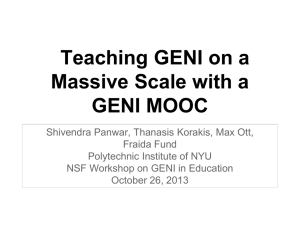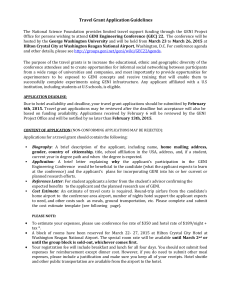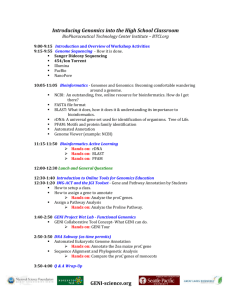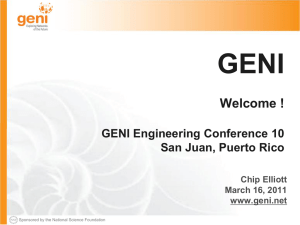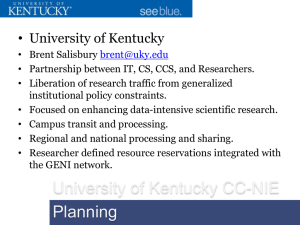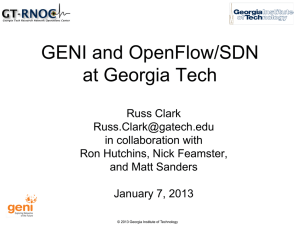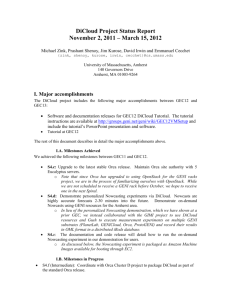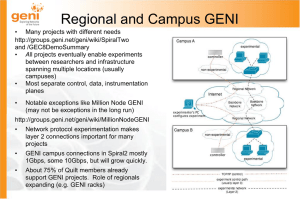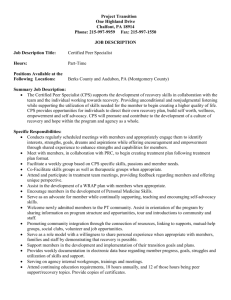GENI security
advertisement
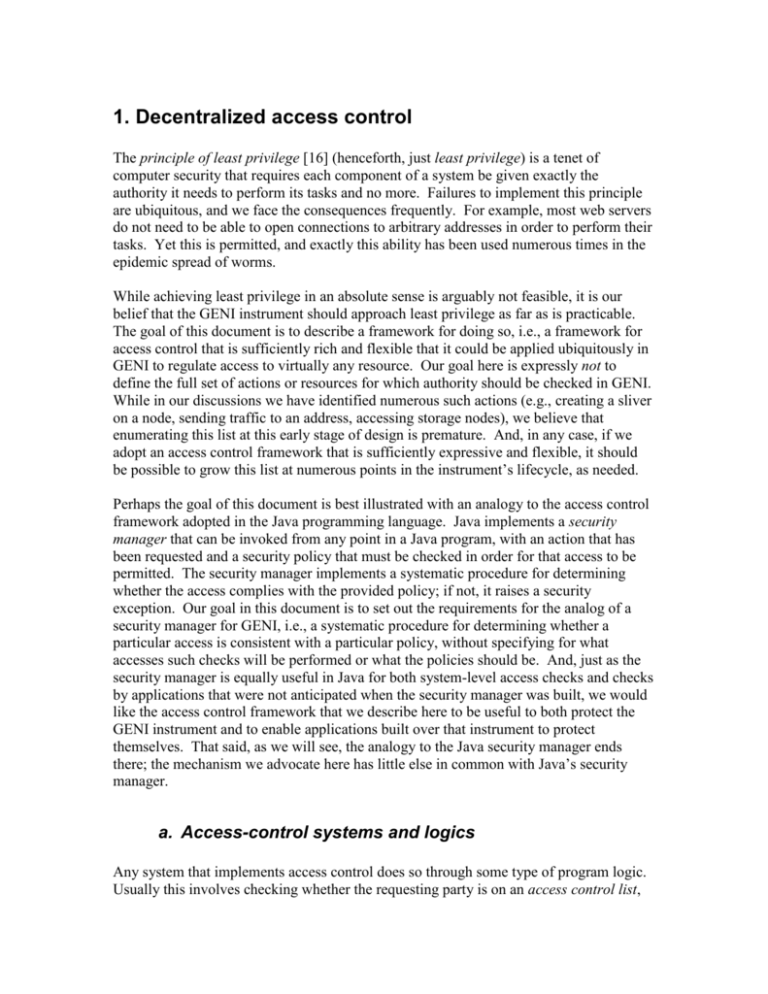
1. Decentralized access control The principle of least privilege [16] (henceforth, just least privilege) is a tenet of computer security that requires each component of a system be given exactly the authority it needs to perform its tasks and no more. Failures to implement this principle are ubiquitous, and we face the consequences frequently. For example, most web servers do not need to be able to open connections to arbitrary addresses in order to perform their tasks. Yet this is permitted, and exactly this ability has been used numerous times in the epidemic spread of worms. While achieving least privilege in an absolute sense is arguably not feasible, it is our belief that the GENI instrument should approach least privilege as far as is practicable. The goal of this document is to describe a framework for doing so, i.e., a framework for access control that is sufficiently rich and flexible that it could be applied ubiquitously in GENI to regulate access to virtually any resource. Our goal here is expressly not to define the full set of actions or resources for which authority should be checked in GENI. While in our discussions we have identified numerous such actions (e.g., creating a sliver on a node, sending traffic to an address, accessing storage nodes), we believe that enumerating this list at this early stage of design is premature. And, in any case, if we adopt an access control framework that is sufficiently expressive and flexible, it should be possible to grow this list at numerous points in the instrument’s lifecycle, as needed. Perhaps the goal of this document is best illustrated with an analogy to the access control framework adopted in the Java programming language. Java implements a security manager that can be invoked from any point in a Java program, with an action that has been requested and a security policy that must be checked in order for that access to be permitted. The security manager implements a systematic procedure for determining whether the access complies with the provided policy; if not, it raises a security exception. Our goal in this document is to set out the requirements for the analog of a security manager for GENI, i.e., a systematic procedure for determining whether a particular access is consistent with a particular policy, without specifying for what accesses such checks will be performed or what the policies should be. And, just as the security manager is equally useful in Java for both system-level access checks and checks by applications that were not anticipated when the security manager was built, we would like the access control framework that we describe here to be useful to both protect the GENI instrument and to enable applications built over that instrument to protect themselves. That said, as we will see, the analogy to the Java security manager ends there; the mechanism we advocate here has little else in common with Java’s security manager. a. Access-control systems and logics Any system that implements access control does so through some type of program logic. Usually this involves checking whether the requesting party is on an access control list, but it might additionally involve checking whether that party is a member of a group, for example. In distributed systems, access-control decisions often must be based on policies (e.g., expressing delegations of authority, group memberships, and so forth) of different principals in the system. It is typical for these policies to be encoded in digitally signed credentials that must be assembled and presented to the resource monitor for evaluation. Numerous such systems and standards have been developed in the research community (e.g., [17][6][7][8][5][11][4]). Since the early 90s, efforts to gain assurance in decentralized access-control systems involved modeling access-control policy and the system enforcement in a formal logic (e.g., [1][10][12][13]), so that claims about it could be made precise and verified. More recently, formal logics have been explored as a means to implement the access-control decision procedure (e.g., [1]), and have been used in such a capacity in a handful of research systems (e.g., [3]). This increases assurance further by minimizing the gap between the logic (about which results are proved) and the system implementation. While detailing an access-control logic is outside the scope of this document, it is worthwhile to summarize how such a logic is used. In such a system, formulas of the logic are instantiated from digitally signed credentials. An example of such a credential might be a traditional certificate issued by a certification authority, but more generally the credentials can utilize richer constructs in the logic, such as groups or roles. The inference rules of the logic are then applied to these formulas to construct a proof of a required access-control policy. The required access-control policy can be different per resource being accessed, and its formal statement will typically involve a nonce identifier so that the resulting proof cannot be replayed. b. Proposed resource monitor From Section 1.a, we can see that gaining access to a resource can be decomposed into two distinct steps: constructing a proof that the access complies with access-control policy, and checking that the proof is valid. The resource monitor we propose to serve as the heart of access control in GENI is a component that performs the latter, i.e., a generic proof checker for a suitable access-control logic. That is, provided a security policy expressed as a formula of the logic and a claimed proof (including digitally signed credentials) that a request satisfies this security policy, this component would verify the digital signatures on all certificates to ensure their validity and then verify that the claimed proof using them is indeed a valid proof of the security policy. This component embodies significant design decisions, not the least of which is with respect to what logic the resource monitor verifies the proof. There appears to be a tradeoff between the expressiveness of this logic and what can be proved about the resulting system. For example, in the proposal of Appel and Felten [1], higher-order logic is used, which favors extensibility over what can be proved. A more restrictive logic might be more appropriate for an initial GENI rollout. 2. Protecting private keys The access control architecture presented in Section 1 is only as secure as the private keys that contribute statements to it. Other private keys might play a similarly important role for GENI, e.g., as the means to decrypt sensitive data that is collected and stored on untrusted (from the user’s perspective) GENI nodes. For this reason, we believe it important to provide facilities that help a GENI user or administrator protect her long-term private key (or any other private key for which the use should be contingent on consent of a user) from misuse if it is disclosed to an adversary. There are a range of protections that might be considered. Password encryption of the private key has the obvious advantage of being familiar to the majority of would-be GENI users, but places an undue burden on users to choose passwords that will resist an offline dictionary attack. In addition, a key that succumbs to such an attack can be used by the adversary indefinitely, at least until the components that trust the corresponding public key (e.g., to verify signatures or create encryptions) cease doing so. Storing the key solely on a hardware token (e.g., smartcard) can make it significantly less likely that an adversary will gain access to a private key, and this solution is appropriate for keys whose compromise could have far-reaching consequences (e.g., the keys of powerful GENI administrators). However, this solution brings additional expense and risks of failure (e.g., due to the token being temporarily or permanently misplaced, or the token itself failing). In addition, despite its availability for many years, this approach has reached deployment in primarily only high-security environments, raising questions about its acceptability more generally. As such, we recommend this approach be made optional for the vast majority of GENI users and personnel. A middle-ground that we recommend be made available for general GENI users and maintenance personnel (e.g., at the various institutions where it has points of presence) is one that retains the familiar interface of a password-protected private key, but without relying on the user to select a password that could withstand an offline dictionary attack (e.g., a 4-digit PIN would suffice, just as for an ATM) and without requiring the deployment of hardware tokens. The approach shares control over the use of a private key with a GENI component; we will call this component a capture-protection server (CPS) and a private key that it protects a capture-protected key (CPK). The role of the CPS is to limit the use of a CPK to only the owner of that key (i.e., the user who can supply the PIN for that CPK), and optionally to provide the means by which the key can be disabled (temporarily or permanently) even for the legitimate user or someone who can impersonate that user. While disabled, the CPK cannot be used to perform cryptographic operations. Proposals to implement such a CPS go back at least to Yaksha [9], though modern proposals [14] offer better management properties (e.g., the CPS does not require initialization per user) and better minimize trust in the CPS. In particular, the CPS need not be in the trusted computing base for secrecy of the CPK: as long as the CPK itself remains undisclosed, the compromise of the CPS does not enable misuse of the key. We do not recommend that there be only one CPS for all of GENI. GENI Central can provide a default CPS, though it should be possible to change the CPS used for a private key, e.g., to a CPS newly set up by an institution to protect its users’ keys. This is in keeping with the tenet that ultimately the only authority GENI Central has is that which institutions place in it. Modern proposals support such functionality, as well [15]. 3. References [1] M. Abadi. On SDSI’s linked local name spaces. Journal of Computer Security 6(12):321, October 1998. [2] A. W. Appel and E. W. Felten. Proof-carrying authentication. In Proceedings of the 6th ACM Conference on Computer and Communications Security, November 1999. [3] L. Bauer and M. A. Schneider and E. W. Felten. A general and flexible accesscontrol system for the Web. In Proceedings of the 11th USENIX Security Symposium, August 2002. [4] M. Becker and P. Sewell. Cassandra: Flexible trust management, applied to electronic health records. In Proceedings of the 17th IEEE Computer Security Foundations Workshop, pages 139154, 2004. [5] M. Blaze, J. Feigenbaum, J. Ioannidis and A. D. Keromytis. The KeyNote trust management system, version 2. IETF RFC 2704, September 1999. [6] M. Blaze, J. Feigenbaum and J. Lacy. Decentralized trust management. In Proceedings of the 1996 IEEE Symposium on Security and Privacy, pages 164173, May 1996. [7] E. Belani, A. Vadhat, T. Aderson and M. Dahlin. The CRISIS wide area security architecture. In Proceedings of the 7th USENIX Security Symposium, January 1998. [8] C. Ellison, B. Frantz, B. Lampson, R. L. Rivest, B. M. Thomas and T. Ylonen. SPKI certificate theory. IETF RFC 2693, September 1999. [9] R. Ganesan. Yaksha: Augmenting Kerberos with public key cryptography. In Proceedings of the 1995 ISOC Network and Distributed System Security Symposium, pages 132143, February 1995. [10] J. Halpern and R. van der Meyden. A logic for SDSI’s linked local name spaces. Journal of Computer Security 9:4774, 2001. [11] T. Jim. SD3: A trust management system with certified evaluation. In Proceedings of the 2001 IEEE Symposium on Security and Privacy, pages 106115, May 2001. [12] B. Lampson, M. Abadi, M. Burrows and E. Wobber. Authentication in distributed systems: Theory and practice. ACM Transactions on Computer Systems 10(4):265310, November 1992. [13] N. Li and J. C. Mitchell. Understanding SPKI/SDSI using first-order logic. International Journal of Information Security, 2004. [14] P. MacKenzie and M. K. Reiter. Networked cryptographic devices resilient to capture. International Journal on Information Security 2(1):120, November 2003. [15] P. MacKenzie and M. K. Reiter. Delegation of cryptographic servers for captureresilient devices. Distributed Computing 16(4):307327, December 2003. [16] J. H. Saltzer and M. D. Schroeder. The protection of information in computer systems. Proceedings of the IEEE 63(9)12781308, September 1975. [17] E. Wobber, M. Abadi, M. Burrows and B. Lampson. Authentication in the Taos operating system. ACM Transactions on Computer Systems 12(1):332, February 1994.
